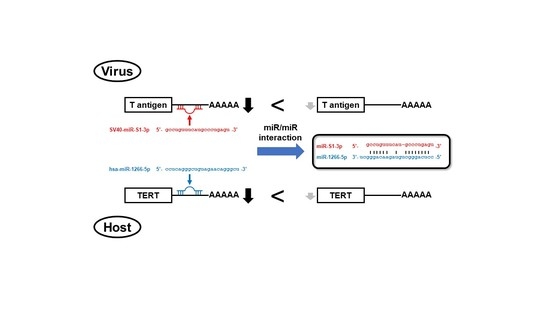SV40 miR-S1 and Cellular miR-1266 Sequester Each Other from Their Targets, Enhancing Telomerase Activity and Viral Replication
Abstract
Share and Cite
Takahashi, T.; Ichikawa, H.; Okayama, Y.; Seki, M.; Hijikata, T. SV40 miR-S1 and Cellular miR-1266 Sequester Each Other from Their Targets, Enhancing Telomerase Activity and Viral Replication. Non-Coding RNA 2022, 8, 57. https://doi.org/10.3390/ncrna8040057
Takahashi T, Ichikawa H, Okayama Y, Seki M, Hijikata T. SV40 miR-S1 and Cellular miR-1266 Sequester Each Other from Their Targets, Enhancing Telomerase Activity and Viral Replication. Non-Coding RNA. 2022; 8(4):57. https://doi.org/10.3390/ncrna8040057
Chicago/Turabian StyleTakahashi, Tetsuyuki, Hirona Ichikawa, Yukiko Okayama, Manami Seki, and Takao Hijikata. 2022. "SV40 miR-S1 and Cellular miR-1266 Sequester Each Other from Their Targets, Enhancing Telomerase Activity and Viral Replication" Non-Coding RNA 8, no. 4: 57. https://doi.org/10.3390/ncrna8040057
APA StyleTakahashi, T., Ichikawa, H., Okayama, Y., Seki, M., & Hijikata, T. (2022). SV40 miR-S1 and Cellular miR-1266 Sequester Each Other from Their Targets, Enhancing Telomerase Activity and Viral Replication. Non-Coding RNA, 8(4), 57. https://doi.org/10.3390/ncrna8040057





